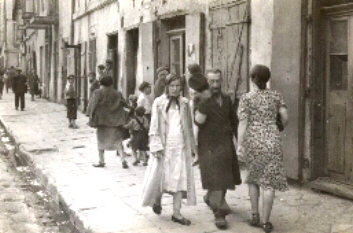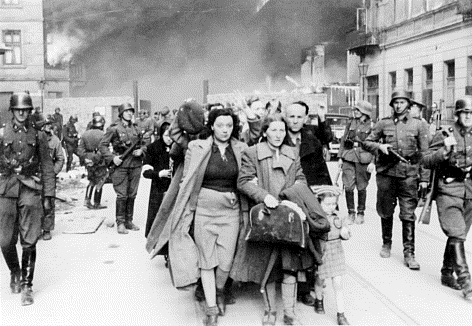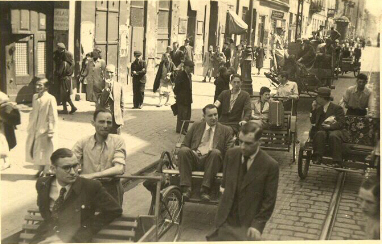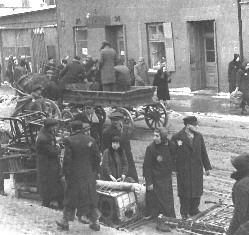Holocaust Education & Archive Research Team |
Ghettos
Introduction to the Ghettos of the Holocaust
Jewish Ghettos The Judenrat Judenrat Leaders Prominent Jews
| |||
The Ghettos of the Holocaust
The ghetto was not a Nazi invention. Its origins can be traced back to medieval times, when restrictions on the places where Jews were allowed to reside were commonplace throughout Europe. Although this restriction is usually perceived as relating to towns or cities, it even applied in certain cases to entire countries. For example, in 1791, Catherine the Great created the Pale of Settlement in western Russia. Most Jews were only allowed to reside within the Pale, and even there some cities were prohibited to them. Even earlier, in 1290, Edward I had expelled all Jews from England. They were not to be officially permitted to return until the time of Oliver Cromwell in 1655. To an extent, only being allowed to live in specified parts of a city presented no great problems to an almost wholly Orthodox community. Judaism, with its many religious requirements, encouraged Jews to live in close proximity to each other and their religious institutions. Whilst they were generally free to come and go within the towns in which they dwelt, until the mid-19th century there were special Jewish districts called "Jewish towns" in many larger Polish towns and cities. This was especially true of places that until the end of the 18th century were the property of Polish kings. Jews could only live in these specified districts. They were not permitted to live inside the towns' walls, in the so-called "Christian towns", although Jews were permitted to trade with Christians and to even rent small shops within the Christian sector. In towns belonging to the church, Jews were not allowed to settle at all until 1861-1862. By way of contrast, in smaller provincial towns which were the private property of aristocratic families, Jews were unreservedly welcomed because of the economic benefits they brought.
It was frequently a less than idyllic existence, but it was bearable. Anti-Semitism was endemic, based upon religious bigotry and economic envy. From time to time it erupted in pogroms, most notoriously under the leadership of Bogdan Chmielnicki, who between1648-1656 is estimated to have murdered 500,000 Jews in Poland and central and eastern Ukraine – a loss of Jewish life not to be exceeded until the years of the Holocaust. The assassination of Czar Alexander II in 1881 unleashed a wave of anti-Jewish violence that resulted in the start of the great emigration from Russia and Congress Poland to the west, a process that continued largely uninterrupted until the outbreak of the First World War. An even bloodier outbreak of pogroms in 1903-1906 only served to increase the flood of eastern European Jews seeking shelter from persecution. Having immigrated to new countries, Jews tended to congregate in particular areas of a town or city even when no longer forced to do so, for the reasons already stated. That was a matter of choice. The Nazis eliminated that choice. Although ghettoisation as such was never introduced in the Reich itself, and only slowly appeared in the countries occupied by Germany, its effect was intentionally lethal. As will be detailed, whilst ghettos might be “open”, permitting some communication with the outside world, or “closed”, virtually sealed off from all exterior contact, almost all of them shared certain features in common. Dilapidated housing, appalling sanitary conditions, inadequate and poor quality food, absence of medical supplies and facilities – this was the lot of the ghetto dweller. And most of those ghetto dwellers also shared a common end. They died of starvation, disease and exhaustion within the ghetto, or at shooting pits and death camps outside of it.
The first Nazi ghettos were never intended to be more than temporary, an interim concentration of Jews pending a decision concerning what the “Final Solution of the Jewish Question” was going to be. That decision went through many convoluted changes before its ultimate determination. The policy towards the incarcerated Jews also changed as the realisation dawned on the Germans that a captive labour force could be put to better use than sweeping snow, or breaking rocks. Later, the ghettos served as convenient points at which to concentrate that Jewish labour force prior to its liquidation. Not every town had a ghetto. Reinhard Heydrich’s strategy was to remove Jews from small villages and towns to larger conurbations. In some cases, ghettos were formed before the initial killing spree, in other cases afterwards. Hundreds of ghettos were established in Nazi occupied Europe, ranging in size from the 445,000 inhabitants of the Warsaw ghetto to those containing just a few families in rural quasi-ghettos. In short, despite Heydrich’s instructions, there was no consistently discernible pattern to ghettoisation, and policy decisions were frequently taken at a local level. As it became increasingly apparent where Nazi policy towards the Jews led, underground movements began to form in the ghettos. They were not always successful in organising resistance, and even if they did, none had a hope of success, but their dignity, courage and sacrifice were to provide an inspiration to generations as yet unborn. Today, the term “ghetto” has acquired a somewhat different meaning. It is no longer applied solely, if at all, to Jews. Any ethnic minority residing near to each other in a specific area of a city create what is often described as a “ghetto.” It may be that the choice of accommodation is forced upon them for economic reasons, but by and large, these communities congregate for the same reasons that Jews once did. It is comforting to be surrounded by one’s peers, religious or racial. But in no way can these modern “ghettos” be compared to the Nazi version. The ghettos of the Holocaust were described by one inmate as “a prison without a roof.” But they were much worse than that. A prison sentence offered at least the prospect of survival. For those interned in the ghettos, there was no such prospect. Slow and lingering, or swift and brutal, their fate was likely to be the same. There were of course survivors, and it is from their evidence and the extraordinarily detailed archives and personal diaries of those who did not survive, that it is possible to construct some kind of historical record of individual ghettos. No writing can begin to adequately describe the misery and despair of life in the ghettos established by the Nazis. But compelled by an ancient tradition to “Schreibt un farschreibt!” – “Write and record!” a legacy was left which at least enables us to attempt to do so.
Sources: Bacon, Josephine. The Illustrated Atlas of Jewish Civilization, Quantum Books Ltd, London, 1998. Hilberg, Raul. The Destruction of the European Jews, Yale University Press, New Haven, 2003 Wistrich, Robert S. Antisemitism - The Longest Hatred, Thames Mandarin, London, 1992.
Photo Sources:
SJ & CW Archive USHMM
COPYRIGHT: BJF H.E.A.R.T 2006
|



